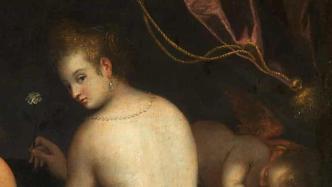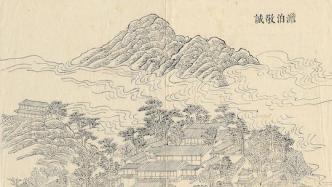
The Hall of Mental Cultivation in the Forbidden City is the place where Qianlong governed and lived in the Qing Dynasty, and it is also an important place for him to collect calligraphy and paintings. Among the more than 100 pieces of calligraphy and painting collections in the Hall of Mental Cultivation, there are not only famous works but also fake ones. Based on the "Shiqu Baoji", Zaoban's work archives, Ming and Qing literati notes, painting history and painting theory, etc., combined with painting inscriptions, seals, painting styles, and postscripts, this article conducts a comprehensive study, and analyzes the authenticity of 12 paintings by female painters Dao Guansheng, Wen Chu, and Chen Shuku in the Hall of Yangxin, so as to deepen the connotation of the history of Qianlong court calligraphy and painting collection.
In the Qing Dynasty, Qianlong not only practiced calligraphy and painting during his spare time in Bingguo, but also paid attention to the collection of calligraphy and painting of previous dynasties. For this reason, he established many collections in the Forbidden City, Yuanmingyuan, Chengde Mountain Resort, Panshan Palace and other places. In the Forbidden City alone, there are dozens of places such as the Hall of Mental Cultivation, Ningshou Palace, Qianqing Palace, Yushufang, Chonghua Palace, Yanchun Pavilion, and Chunhuaxuan. The author has been devoted to the research of ancient female painters for a long time, and in recent years, he has also participated in the original project of Yangxindian. It is found that among all Tibetan areas, Yangxindian has the largest collection of works by female painters, including 5 pieces of Yuan Daosheng, 2 pieces of Mingwenchu, and 5 pieces of Qing Chenshu. These collections have different ways of entering the palace, and there are also genuine and fake ones. Through the study of them, we can get a glimpse of Qianlong's unique aesthetic perspective on the works of female painters.
1. Leading female painters——Dao Sheng, Wen Chu, Chen Shu
Affected by the feudal ritual system, female painters were few and far between, and they did not occupy the mainstream of the painting world. As a result, calligraphy and painting connoisseur Wang Dayu lamented that "Danqing is in the class of ladies, and it is more hidden than visible". Among the rare female painters, Duan Sheng, Wen Chu, and Chen Shu had the highest artistic achievements and the greatest influence.
Duan Sheng (1262-1319), courtesy name Zhongji, also named Yaoji, was born in Qixian Mountain, Wuxing (now Huzhou, Zhejiang Province), and was known as "Mrs. Wei Guo". She was intelligent and quick-witted since she was a child, and she was good at calligraphy and painting, with clear brushstrokes. Later, she enjoyed a high reputation in the history of painting by virtue of her own calligraphy and painting skills, as well as the recommendation of her husband Zhao Mengfu and the Yuan royal family. His ink bamboo paintings have even been lifted to the position of benchmarks. For example, when Jiang Shaoshu commented on Chen Qin's "Ink Bamboo Picture" fan in the Ming Dynasty, he praised it as "quite similar to Mrs. Guan's method"; On the ninth page of "Ink Painting Bamboo" in the book "Family Paintings", I know that I copied "Guan Zhongji 'Conghuang Bijian'", intending to use the name of Guan Zhongji to flaunt the orthodoxy and norms of my bamboo painting.
Wen Chu's influence in the painting world is comparable to that of Guan's. Wen Chu (1595-1634), courtesy name Duan Rong, was born in Cheung Chau (now Suzhou, Jiangsu Province). He was diligent in writing and ink under the instruction of his father Wen Congjian since childhood. Through the copying of "Gold, Stone, Insects, Fruits and Trees" originally collected in the Neifu of the Ming Dynasty, she has practiced the basic skills of brush and ink modeling, drawing lines and haloing colors. After marriage, Wen Chu sketched the flowers and plants in the cold mountains where he lived, and developed his fine observation ability and expressive ability of choosing and choosing objects. In the end, she won praises from many parties for her accurate and vivid brushwork and coloring, and the vividness of flowers, plants, insects and butterflies. Jiang Shaoshu called her: "Innately intelligent, she writes about the freshness of flower buds and calyxes; the branches are gliding, and they are in the state of being exposed to the wind. The stream flowers and tingcao, which cannot be described, can all adorn their life. On the side of the clump, accompanied by aragonite, a kind of rhyme of Qianhua and graceful beauty, overflowing with a little element, although Xu Xiye is wild, it is not an exaggeration." For the past three hundred years, Wen Chu has been the only one who has tweeted about it.” As Wen Chu’s reputation grew, his works became more and more sought after, and a phenomenon of “purchasers from far and near” appeared. At the same time, it also attracted a group of noble concubines and concubines, such as Zhou Shuhu and Zhou Shuxi, who competed to be teachers and study brushwork.
Although Chen Shu in the Qing Dynasty was not as influential as Duan Sheng and Wen Chu, her artistic attainments were not inferior to her predecessors in the slightest. She is the only one among female painters who can paint landscapes, figures, flowers and birds. Chen Shu (1660-1736), courtesy name Nanlou, nickname Shangyuan Disciple, was born in Xiushui (now Jiaxing, Zhejiang Province), and was the mother of Qian Chenqun, one of the five ministers of Qianlong. Chen Shu's landscape paintings not only imitated ancient figures, such as Yuan Wangmeng, Cao Zhibai, Ming Tang Yin, etc., but also actively observed nature and drew inspiration from it. In the end, Chen Shu became the one who painted the most landscape paintings, the most painting styles, and the greatest artistic achievements among female painters. Chen Shu's figure paintings always adhere to the creative purpose of "the painter must be aware of the ups and downs", and pay attention to expressing spirit with form, which is very appealing. Chen Shu's flower-and-bird paintings mainly imitate Chen Chun's freehand brushwork of flowers, with free and easy brush and ink, and a fresh and elegant style of literati painting. Zhang Geng of the Qing Dynasty praised him: "He is good at flowers, birds, grass and insects, his brushwork is old and vigorous, and his wind spirit is simple and ancient." Qin Zuyong believed that his flower and bird paintings were "elegant in wind and spirit, witty and natural, and extremely elegant."
2. Appreciation of Qianlong
Qianlong, who was keen on traditional calligraphy and painting, highly admired Dao Guansheng, Wen Chu, and Chen Shu, which can be seen from his imperial inscription poems on their works. For example, the title of Guan's "Picture of Dead Wood, Bamboo and Stone" "I love him freehand brushwork, the beauty of the boudoir, and the style is vivid". I admire the elegant and elegant charm of Guan's pen and ink. Commenting on Wen Chu's "Sketch of Butterflies and Flowers from Life on Flowers and Stones", "the whole body is graceful and light, and the most affectionate is before the wind blows." I admire Wen's vivid charm of flowers and butterflies. On Chen Shu's "Sketch from Life" "the structure is always without a heroine". He also once praised Chen Shu's "exquisite painting technique, which can imitate other masters." In short, Qianlong highly praised the artistic creation of the three from different angles such as painting style, level technique, subject matter and content.
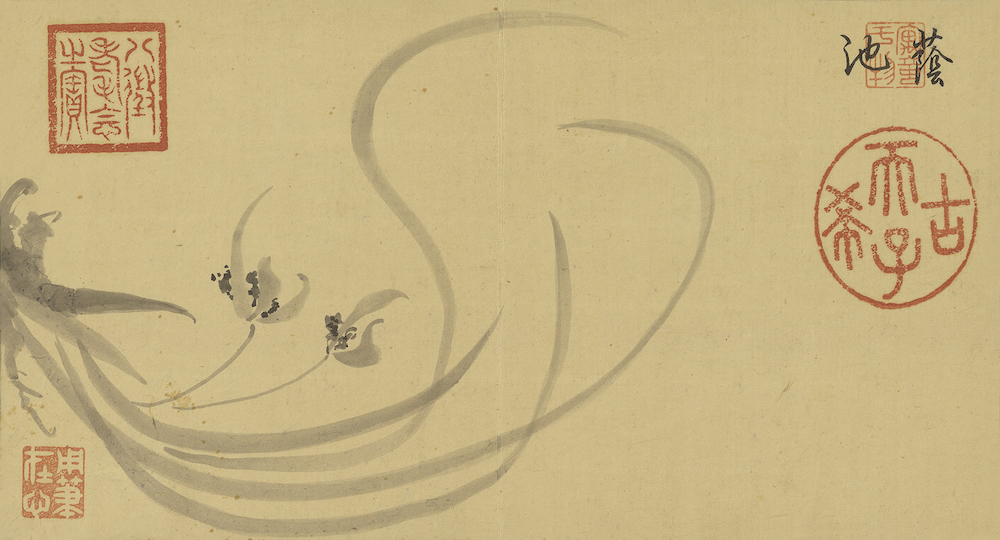
〔Picture 1〕 Qing Qianlong "Imitation of Zhao Wenchu's Ink Orchid Picture" volume, collected by the Palace Museum
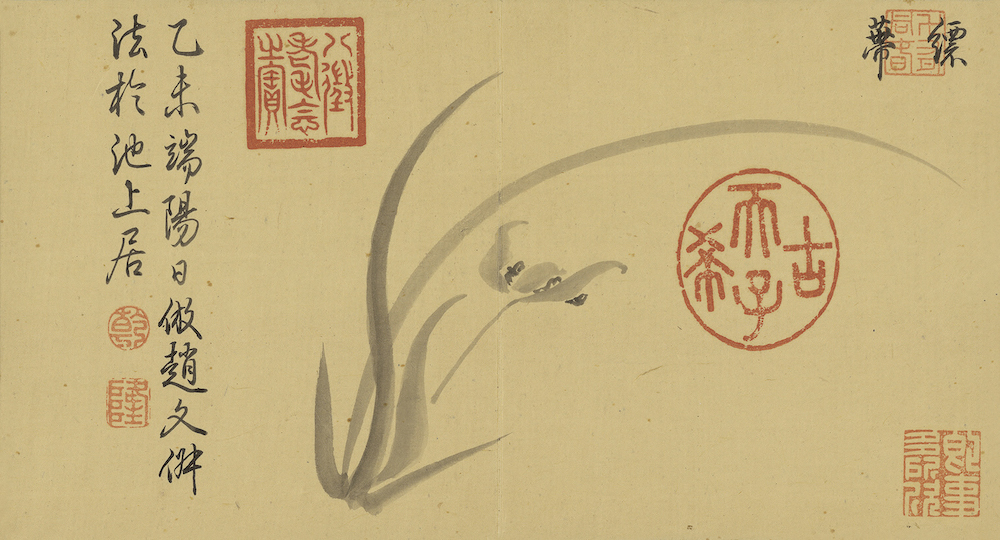
(Picture 1) Qing Dynasty Qianlong "Imitation of Zhao Wenchu's Ink Orchid Picture" Book Collection of the Palace Museum
In addition to the praise of imperial poems, Qianlong's appreciation of Guan Guansheng, Wen Chu, and Chen Shu was also reflected in imitation and copying. There are mainly two ways: one is Qianlong personally imitating the pen; the other is making the court painter imitate. According to the work record of the manufacturing office, in December of the 23rd year of Qianlong (1758), Gui Yuan, the chieftain, handed over Qianlong's "Royal brush imitating pipes to ascend the 'ink bamboo' hanging scroll" to the artisans of Qixiang Palace for mounting. Qianlong Yiwei (1775), who was nearly sixty-five years old, painted the "Molan Picture" album (Figure 1), and opened the title at the end: "Yiwei Duanyang Day, imitating Zhao Wenchu's method to live in Chishang." Congratulations to Wen Chu. Afterwards, Qianlong attached great importance to his set of imitations, not only stamping various idle stamps on the painting pages. For example, "everything is in the same spring", "it is a lot of joy", "use the pen in the heart", "meaning in things", "several seats have a lingering fragrance" means to write first", etc., and stamped the very formal seals of "Ancient Xi Tianzi" and "Eight Signs and Nian Zhibao" in his later years. At the same time, he also decreed that these four pages of paintings should be framed into a book, just like his imitation of "Dongguansheng'mozhu' hanging scroll", to be preserved for a long time.
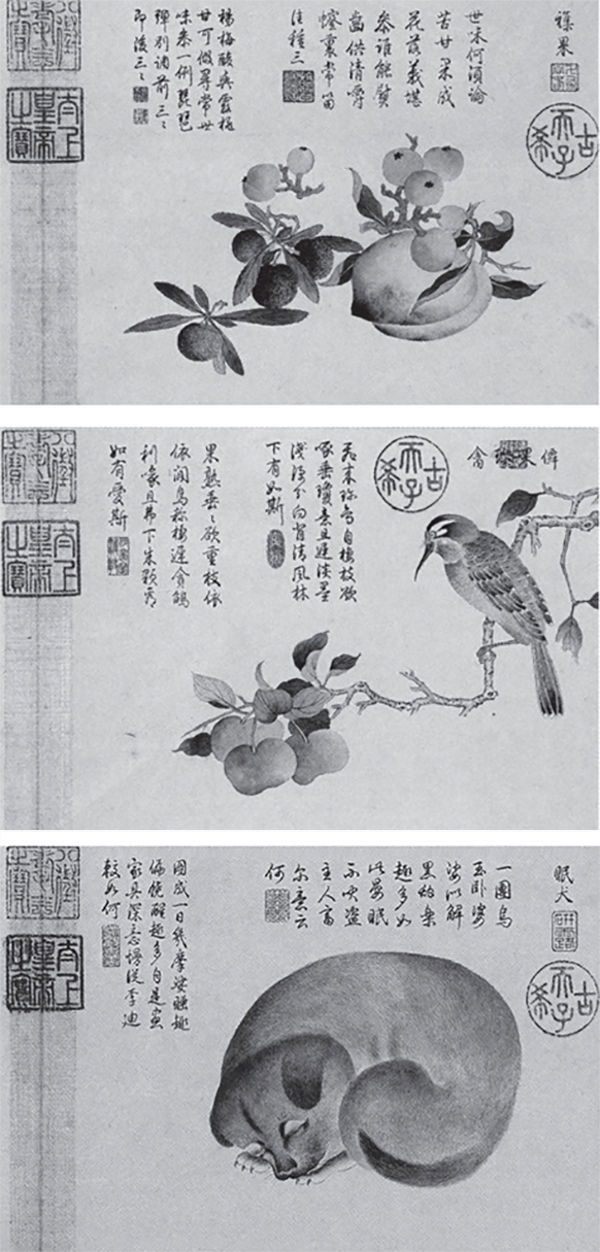
(Picture 2) Qing Jin Tingbiao "Imitation of Chen Calligraphy and Miscellaneous Paintings" volume (partial) Collection of the National Palace Museum, Taipei Collected from Volume 27 of "Calligraphy and Painting Catalog of the National Palace Museum", Taipei National Palace Museum, 2008, pp. 177-178
Another way Qianlong expressed his appreciation for female painters was to order court painters to come and copy them. According to the records of the work of the manufacturing office, in September of the ninth year of Qianlong (1744), Qianlong issued a decree "Ding Guanpeng imitated the painting of Guanyin, imitating the pipeline, and Tang Dai's painting with stones and seawater". After that, Jin Tingbiao was ordered to copy the volume of "Miscellaneous Paintings". In the 30th year of Qianlong's reign (1765), Qian Chenqun, the eldest son of Chen Shu, presented to Qianlong the album "Miscellaneous Paintings" inscribed by his mother Chen Shuhui and his father Qian Lunguang. Qianlong couldn't put it down, but finally decided to return this album to Qian Chenqun. The reason was: "This album was kept by Qian Chenqun's parents, and now Chen Qun wants to publish "Shiqu" to last forever. I think that "Shiqu" contains many paintings of Chen Qun's mother, and I can't bear to keep it." However, before returning the album, he personally wrote a seven-character poem for each album (ancient wood Xiuhuang, Xianguo rare birds, miscellaneous fruits, sleeping dogs, Chunxi water tribe, etc.). And "order Jin Tingbiao to imitate it into a book, record the original title and include it in the art forest of "Shiqu", and add this good story" (Fig. 2). This achieves the purpose of not only taking away the love of the courtiers, but also being able to watch the album at any time.
Since the Yongzheng Dynasty, the Hall of Mental Cultivation has become an important place where the emperors of the Qing Dynasty handled government affairs and lived. Qianlong lived here for 63 years. For the convenience of viewing, he collected his favorite and important masterpieces in the history of calligraphy and painting, such as Jin Wang Xizhi's "Quick Snow and Sunny Post", Wang Xianzhi's "Mid-Autumn Post", Wang Xun's "Bo Yuan Post", Zhao Mengfu's "Lotus Water Bird Picture" in Yuan Dynasty, Wang Zhenpeng's "Bo Ya Guqin Picture" and so on. At the same time, he also treasured the paintings of Guan Sheng, Wen Chu, and Chen Shu here, which not only shows that he attaches great importance to their paintings, but also shows that he believes that the artistic level of Guan, Wen, and Chen can be compared with these famous works of the past dynasties [Table 1].

What needs to be added is that there are 5 pieces of paintings collected by Guan Guansheng in the Hall of Mental Cultivation. In addition to the 4 pieces recorded in the "Shiqu Baoji", there is also a volume of "Mangosteen Picture" recorded in the work files of the Ministry of Internal Affairs. Words, at the right time, enter the first class in the Hall of Mental Cultivation". The strange thing is that the "Shiqu Baoji First Edition" compiled by the Neifu in the ninth year of Qianlong (1744) and the subsequent sequel and third edition did not include the above three paintings. At present, their whereabouts are unknown.
3. Distinguishing the authenticity of the paintings by Guan Guansheng, Wen Chu and Chen Shu in the Hall of Mental Cultivation
Not all of the paintings and calligraphy by Guan Sheng, Wen Chu, and Chen that were admired by Qianlong and stored in the Hall of Mental Cultivation are authentic works, but authentic works, counterfeit works and dubious works coexist. They are discussed separately below.
(1) Authentic masterpieces
Among the 12 works of the three men in the Hall of Mental Cultivation, 6 are genuine, namely 5 by Chen Shu and 1 by Wen Chu.
The route for Chen Shu's paintings to enter the palace is clear, and all of them were dedicated to Qianlong by his son Qian Chen Qunjin. Qian Chenqun and Qianlong formed a profound friendship between emperor and minister through poetry, calligraphy and painting. Qian Long admired Qian Chenqun's calligraphy and his ability to sing and harmonize poems and prose. Qianlong once said: "Chen Qun is deep in poetics, and his calligraphy is also old. After living at home, he records and sends more than a hundred pieces of imperial poems every year. Chen Qun not only harmonizes rhymes, but also writes album pages to advance. The album must have postscripts, fonts or cursive. I love it." He is good at painting on various subjects.
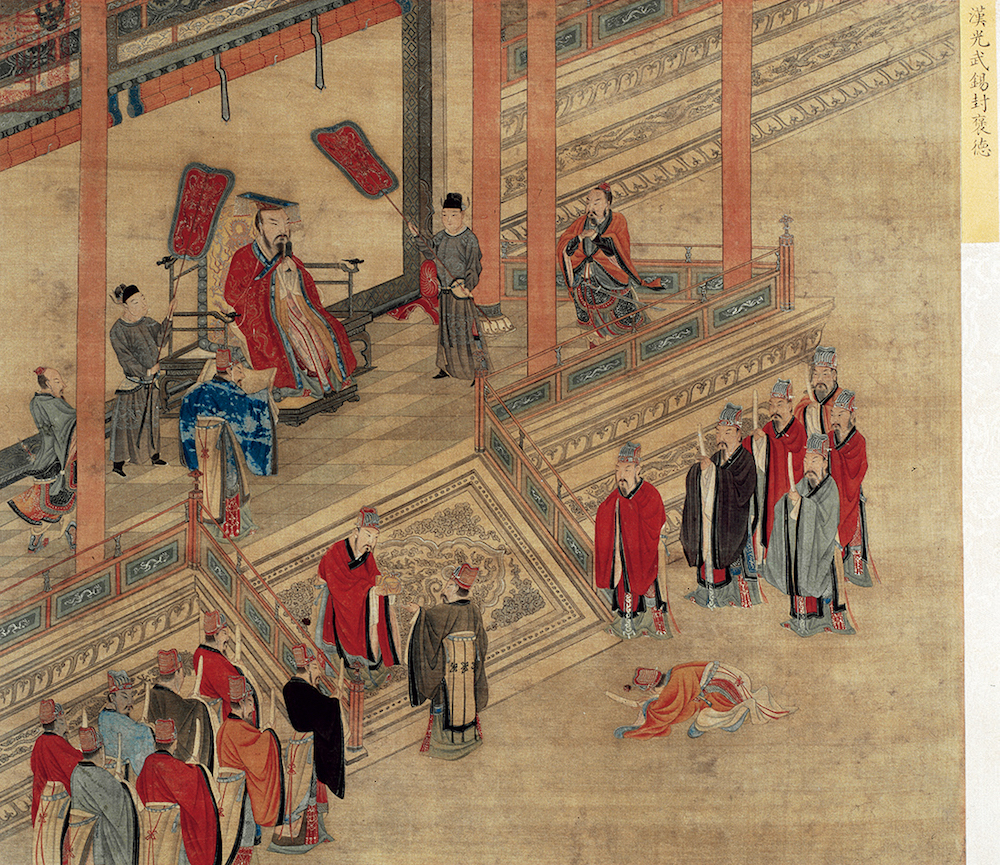
〔Picture 3〕 Qing Dynasty Chenshu "The Map of the Daoist System of the Emperors of Past Dynasties" (partial) Collection of the Palace Museum
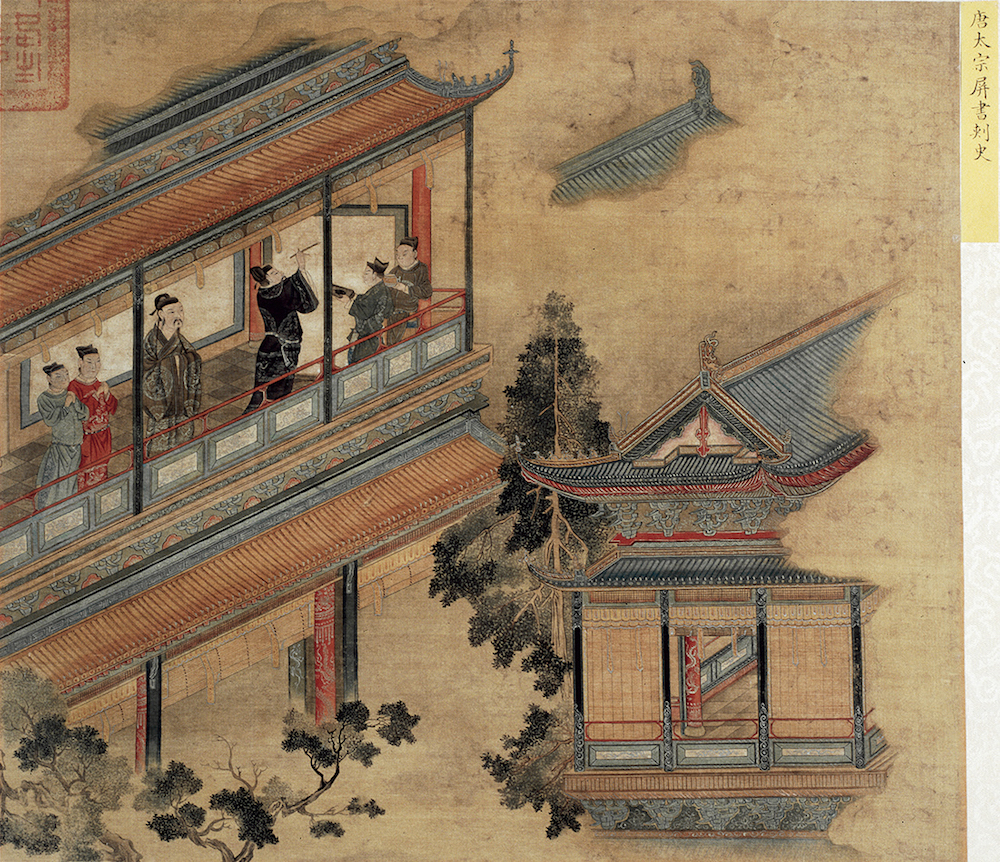
〔Picture 3〕 Qing Dynasty Chenshu "The Map of the Daoist System of the Emperors of Past Dynasties" (partial) Collection of the Palace Museum
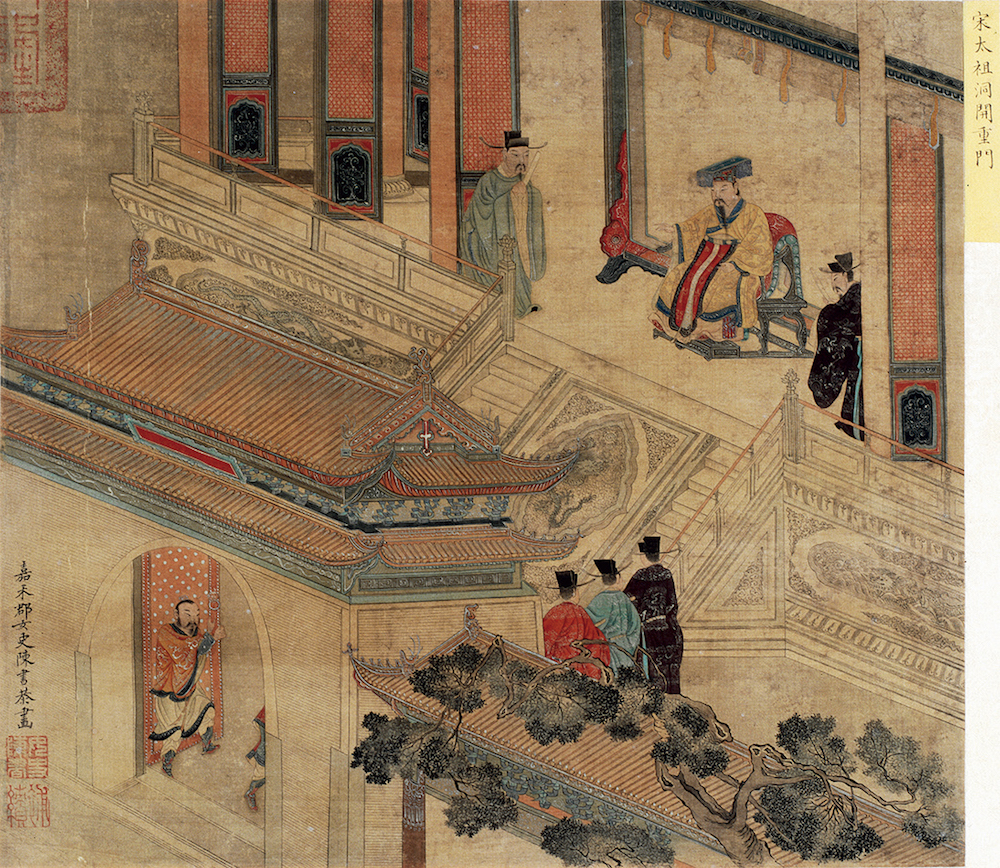
〔Picture 3〕 Qing Dynasty Chenshu "The Map of the Daoist System of the Emperors of Past Dynasties" (partial) Collection of the Palace Museum
The first work of Chen Shu presented by Qian Chenqun to the palace was the book "Taoist Map of the Emperors of Past Dynasties" (Fig. 3), which depicts the virtuous monarchs who were arrested from the Five Emperors in the Tang and Song Dynasties. When Qian Chenqun presented this album, he was serving as the Minister of the Ministry of Criminal Justice. At that time, he didn't know whether the work was worthy of the purpose, so he specially attached a letter to explain the reason and anxiety of dedicating this painting. What Qian Chenqun didn't expect was that Qianlong liked this picture album very much. Not only did he inscribe "Qian Chenqun's Jin Yimu Chen's paintings" with the imperial pen, but also stamped the seal of "Qianlong Yulan Zhibao" to show his importance.
Qian Chenqun posted on Chen Shu's book "Taoist Maps of the Emperors of Past Dynasties": "I would like to count sixteen albums drawn by my mother. I don't think they are shabby. I would like to draw a song for each picture, decorate it in another book, and present it to the imperial audience. I am so trembling that I am overwhelmed..."
Some of Chen Shu's other paintings were presented separately by Qian Chenqun like the book "Taoist Map of Emperors in Past Dynasties", and some were presented together with Qian Chenqun's poems and essays. For example, when Qianlong inscribed Chen Shu's "Picture of Secluded Residence in Qingxia" into a fan, he specifically indicated that this picture was "introduced with his son Chen Qun's "Night Tour Mountain and Moon Song"". See also Qianlong's inscribed Chen Shu "Mountain Dwelling Paintings" saying: "In the past, Chen Qun's poems and poems were included in this fan." When Qianlong inscribed another piece of Chen Shu's "Imitation of Wang Meng's Summer Mountain Dwelling Picture", there was also "When Chen Qun lived at home, he presented the convenience of Jinhe poetry and presented the picture". It can be seen that the way for Chen Shu's works to enter the palace is simple, pure and direct. From this, it is speculated that the five Chen Shu paintings hidden in the Hall of Mental Cultivation should also be donated to the palace through Qian Chenqun, and this is the guarantee to prove that they are authentic.
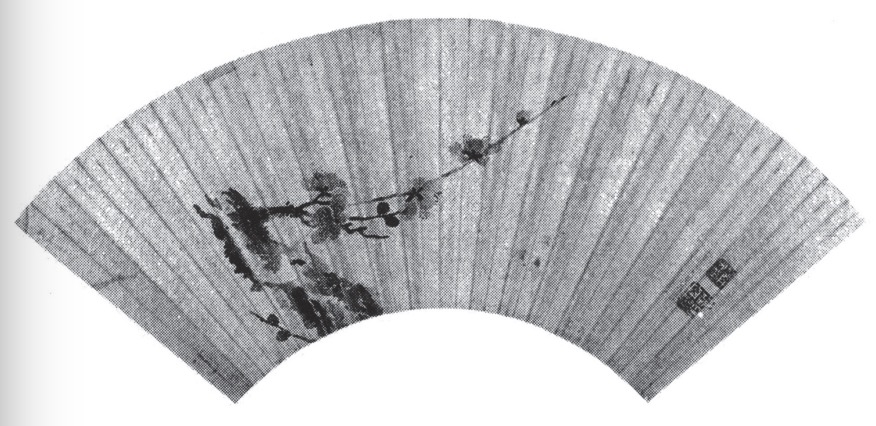
(Picture 4) Fan page of Ming Wenchu's "Momei Tu", collected by the National Palace Museum, Taipei, from "Calligraphy and Painting Illustrated Catalog of the Palace Museum", Volume 30, National Palace Museum, Taipei, 2011, p. 234

〔Picture 5〕 Ming Dynasty Wenchu "Xuanshi Tu" axis Collection of the Palace Museum
Compared with Chen Shu's paintings with clear sources, the fan pages of "Mo Meitu" in the Tibetan language of Yangxindian (Figure 4) have unknown sources. This fan page is the 16th piece in the "Ming Ren Instant Face Painting" (Volume 4) previously collected by the Qing Palace, and the material is the gold paper used by Wen Chuguan. There is no ink inscription of Luo Wenchu on the picture, but there are "Zhao Wenchu seal" and so on. Wen Chu's seals are generally divided into three categories: one is the seal of his own name and name, such as "Duan Rong", "Wen Duan Rong", "Wen's Duan Rong", "Wen Chu", "Wen Chu's Seal" and "Wen" and "Cu" Lianzhu seal; Leisure and tolerance", etc. The seal inscription on the fan page of "Mo Meitu" belongs to the second category above. The paintings with "Zhao Wenchu seal" include the scrolls of "Poppy Lake Stone Picture" and "Xuan Stone Picture" in the Palace Museum (Figure 5), the fan page of "Xuanhua Picture", "Flower Picture" booklet, and the fan page of "Butterfly Play Picture" collected by the Art Museum of the Chinese University of Hong Kong. In terms of composition, the work is simple and sparse. In terms of form of expression, the painter uses rough and free strokes to thicken the trunk or thin out the branches, and expresses the part of the ancient plum tree in a close-up manner. The overall style of the painting is similar to that of the fans in the "Plum Blossom Picture" collected by Wenchu in the Palace Museum, and the brushwork of plum blossoms in the fan page of "Mo Mei Tu" (Figure 6). Since this fan page is in line with Wen's sealing habits and painting style, it must be authentic.
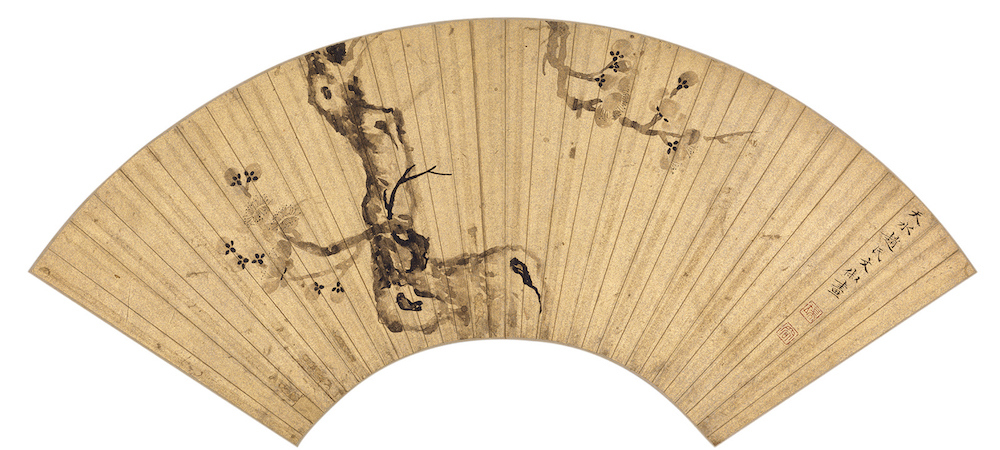
〔Picture 6〕 Fan page of Ming Wenchu's "Momei Tu", collected by the Palace Museum
(2) Counterfeit works
The forgeries of the female painters in the Hall of Mental Cultivation are two works inscribed by Guan Guansheng: the scroll of "Landing at the Bamboo Stream" and the volume of "The Picture of Bilang Temple".
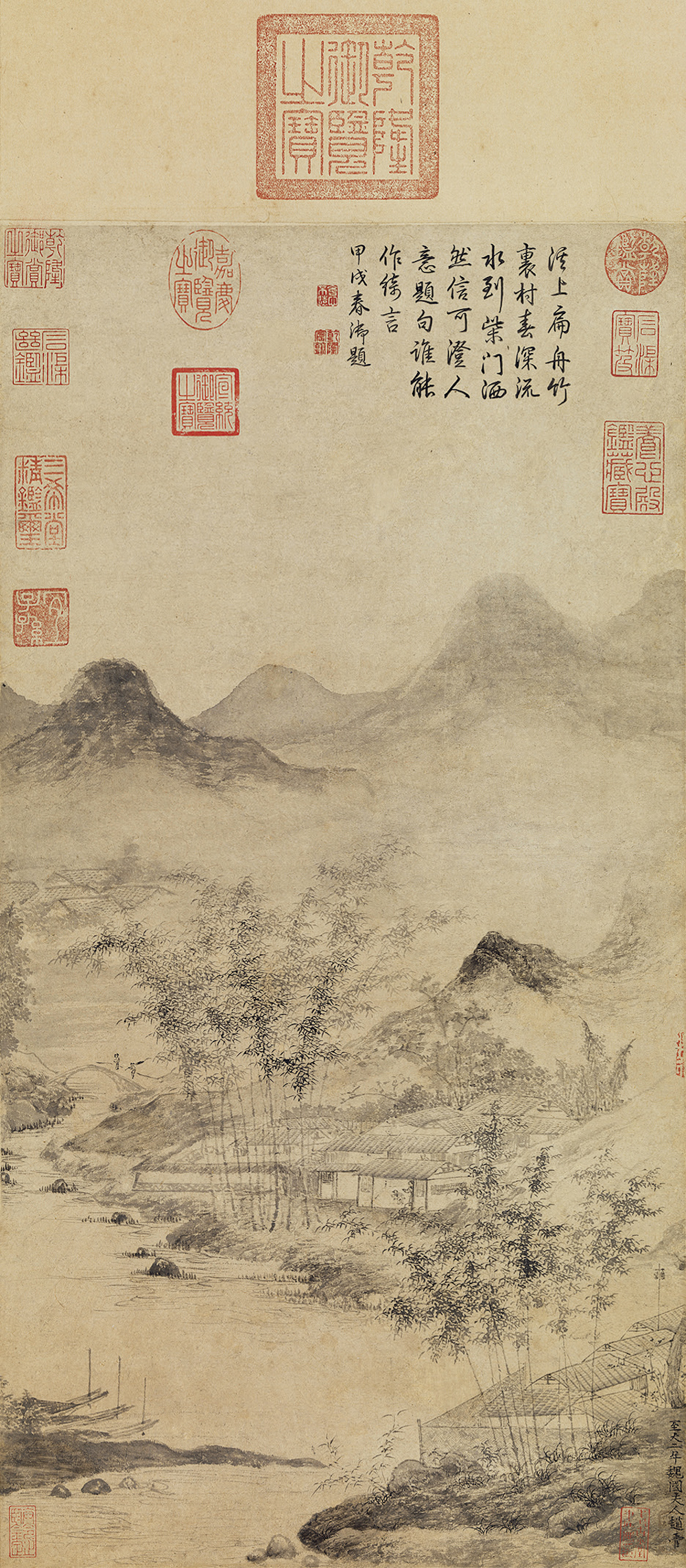
〔Figure 7〕 Yuan Duansheng's "Bamboo Creek Scenic View" axis, collected by the National Palace Museum, Taipei, from the "Painting and Calligraphy Catalog of the Palace Museum" Volume 4, National Palace Museum, Taipei, 1990, p. 91
On the scroll (Fig. 7) of "Landing at the Bamboo Stream", there is an ink inscription "Zhao Guan, Mrs. Wei Guo in the second year of the Zhida Years" in the lower right corner of the painting. The key is that the "second year of Zhida" was 1309, when Duan Sheng had not yet been granted the title of Mrs. Wei. Guan was named Mrs. Wei Guo in the fourth year of Yanyou (1317). See Zhao Mengfu's Epitaph of Mrs. Guan's Wei Guo: "In the fourth year of Yanyou, I entered the Imperial Academy for the purpose of enshrining Mrs. Wei Guo." Figure "Volume [Figure 8] compared with Guan's paintings. After research, Chen Baozhen also believed that the painting "has the style of the Wu School's paintings of the Wu School since the middle of the Ming Dynasty", which is inconsistent with Guan's painting style.
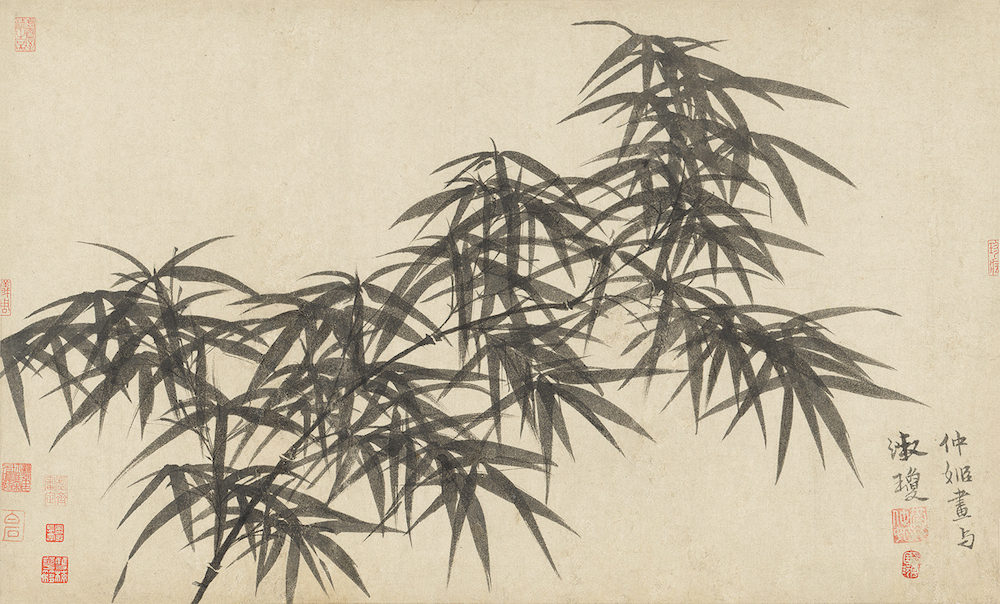
[Figure 8] Zhao Mengfu, Duan Sheng, Zhao Yong, "Zhao Mengfu's Three Bamboos of a Gate" volume (partial) Collection of the Palace Museum
"Bi Lang Nunnery" volume (Fig. 9), the close view is painted with green bamboos facing the wind, and the middle and distant views are painted with undulating peaks. At the end of the picture, there is an inscription titled "Bilang Temple" by Guan Guan, which means that this picture was painted by her for the "Bilang Temple" built by nun Suxue. Title: "...Su Shiyuan talked about Feifei, the jade festival fell, Ya and Yu Shan occasionally built his nunnery, and wrote the 'Bilang Nunnery Picture' as a gift, and remembered it, Guan's Taoism was promoted." After Guan's inscription, Suxue wrote: "I am grateful for Mrs. Wei's protection of the Dharma. The flaw in this picture is that Su Xueba was in "the second year of Zhizhi (1322)", while Guan's family died in the sixth year of Yanyou (1319). It is unreasonable for Suxue to write a postscript to thank Guan three years after Guan's death. Also, looking at Guan Guansheng's inscription and Suxue's postscript, it can be seen that they have a deep friendship, but Suxue wrote Guan's title "Mrs. Wei Guo" as "Mrs. Wei". It is not reasonable for Suxue to make such a clerical error. This picture has been identified by Xu Bangda and Yang Renkai, and they also agree that it is a fake.

〔Picture 9〕 Yuan Daosheng (Biography) "Picture of Bilang Temple" Volume Collection of Jilin Provincial Museum
(3) Difficult to determine the authenticity
The axis of "Sketch from Life" by Wenchu in Yangxindian, the volume of "Cong Yutu" by Duan Sheng, the volume of "He Tu" by Duan Sheng, Zhao Mengfu, and Zhao Yong are all only described in "Shiqu Baoji", and their whereabouts are unknown, so it is difficult to determine the authenticity.
The axis of Wen Chu's "Sketch from Life" is described in "Shiqu Baoji Chubian": "Plain paper, colored paintings. The inscription says: 'Bingyin Jidong, Tianshui Zhao's Wenchu wrote.' Below is the 'Wen' and 'Chu' seals. On the left, there is a seal of 'Song's Rangjia Calligraphy and Painting Library'. The axis is three feet four inches high and one foot six inches wide." According to the description, the inscription of this picture is only 11 characters, except for the creation time and surname. , and no more text. Such a simple inscription form is actually a major feature of Wen Chu's inscription. Although Wen Chu lived in the mid-to-late Ming Dynasty when literati painting flourished and paid attention to the combination of poetry, calligraphy, painting and seal, he was also born in the Wen family with profound cultural heritage, and later married the Zhao family with the same profound cultural heritage (his father-in-law Zhao Huanguang was good at making seals, her mother-in-law Lu Qingzi was good at poetry and painting, and her husband Zhao Lingjun was good at poetry and prose and ancient characters). This feature can be seen in works such as the axis of "Xuan Stone Picture" (Fig. 10), the fan of "Flower Butterfly Picture", and the axis of "Poppy Picture" in the Palace Museum, and the axis of "Spring Eating Leaves" in the National Palace Museum in Taipei.
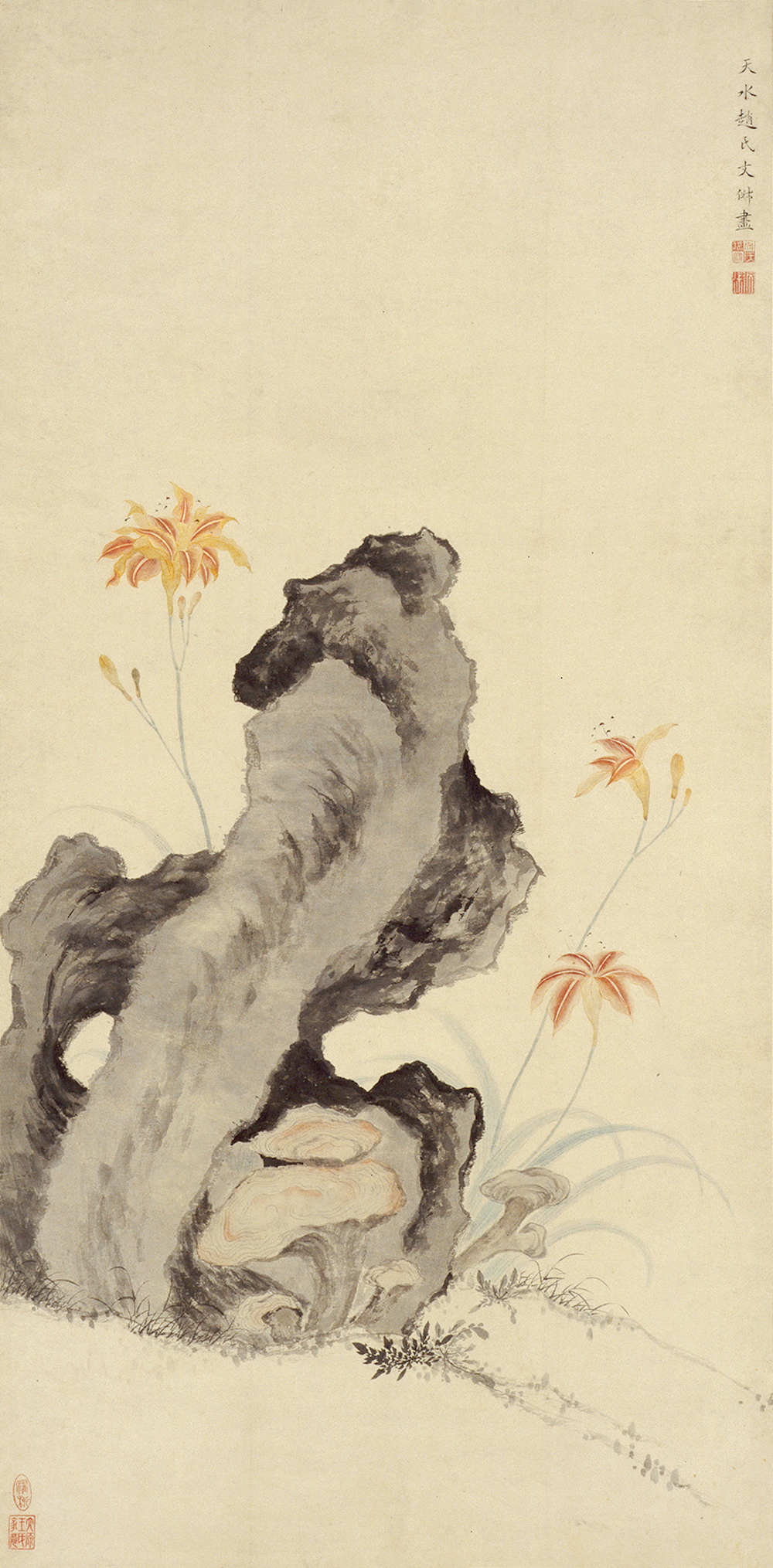
〔Picture 10〕 Ming Dynasty Wenchu "Xuanshi Tu" axis Collection of the Palace Museum
This "Sketch from Life" axis also shows another major feature of Wen Chu's inscription, that is, in addition to writing her own name in the inscription, she also needs to add her husband's "Zhao" surname and the word "Tianshui", the prefect of Zhao's clan, to express the loving relationship between her and her husband. Such as "Plum Blossom Picture" into a fan (Figure 11), "Xuan Stone Picture" axis, "Spring Eating Leaves Picture" axis, "Flower and Bird Picture" axis, etc. are all like this. In short, judging from the description, the title format and content of this picture are consistent with Wen Chu's signing habits.

〔Picture 11〕Ming Wenchu's "Plum Blossom Picture" as a fan, collected by the Palace Museum
From the analysis of the size of the painting center, it is known from the description in "Shiqu Baoji Chubian" that the axis size of "Sketch from Life" is "three feet four inches high and one foot six inches wide", which is equivalent to the current 113.33 cm in length and 53.33 cm in width. The scale of Wenchu painting scrolls is generally no more than 130 cm in length and 65 cm in width. For example, there are two scrolls of "Xuan Shi Tu" in the Palace Museum. One is 123.8 cm in length and 61.3 cm in width, and the other is 130 cm in length and 42.9 cm in width. The axis of "Spring Eating Leaves" collected by the National Palace Museum in Taipei is 78.5 cm long and 32.7 cm wide. Small scale is a major feature of Wen Chu's use of painting materials, which may be related to the purpose and content of his paintings. Wen Chu comes from a wealthy family, and her paintings are purely for her self-entertainment in her boudoir. Therefore, the content of her paintings is very simple, without complicated distant and near scenes, or the transformation of multi-level spaces. She only paints a flower, a stone, or a flower and a butterfly. Such a simple form of sketch painting does not need to be presented in a large size.
Then analyze it from the seal of identification and collection. There is only one Tibetan seal on the axis of "Sketch from Life", which is "Song Shi Rangjia Calligraphy and Painting Library Records", which is the seal of Song Zhi (zi Rangjia), the son of the famous collector Song Luo. Song Luo was born in 1634, the year of Wen Chu's death, and the age difference between the two is decades. Song Luo was the most successful connoisseur of calligraphy and painting in the early Qing Dynasty. After his death, the collection was passed on to his sons Song Zhi (word Shanyan), Song Yun (word Lanhui) and Song Zhi. Later, some of the collection "entered the Qianlong Palace through the hands of Zhang Zhao, An Qi and others." Volume, Yang Jin's "Deep and Beautiful Picture of Streams and Mountains" volume, etc. Since Wen Chu lived in the same period as Song Luo and Song Rongjia and his father and son, and the Song family was also good at appreciating calligraphy and painting, Song Rongjia's appraiser seal can be regarded as circumstantial evidence that "Sketch from Life" is Wen Chu's authentic work. However, since the original work has not been seen yet, this picture can only be classified as authentic or fake for the time being.
Duan Sheng's "Cong Yu Tu" volume can be seen in the description of "Shiqu Baoji First Edition". According to the description, Kang Li's postscript "Weichuan has a thousand acres of Langgan, it is ridiculous that the concubine of Xiang's tears are spotted", Wang Luba "Who painted a hundred thousand poles, how is it different from the valley to see the wind?" characteristics match. It is mentioned in the description that in addition to the Tibetan seals of "Jiaolin Jushi", "Jiaolin Bookstore", "Qiubi", "Yexi Yuyin", "Guanqi Dalue" and "Cangyanzi" on the seals of Liang Qing, there is also Xie Songzhou's "Qingli Lvzhai Collection" and "Songzhou" seals. The body should be like this in the boudoir. This volume was collected by my ancestor Xie Jianchao in the previous generation, and it is extremely precious. Mrs. Gai wrote the bamboo, which is rare, but the picture is the most exquisite, and it should be passed down through the ages. Today, it is from the old Liang Xiangjin. It is also mentioned in the postscript that this picture was originally owned by Xie Jianchao of the Xie family, and later belonged to Liang Qingbiao, and then it was the history of his "secret box". In the early years of Yongzheng, Emperor Yongzheng recruited good judges to enter the palace to examine antiquities. Xie Songzhou was recruited because he was good at connoisseurship. In addition to completing his work in the palace, he also took the opportunity to exchange paintings with the royal family. Therefore, the volume of "Cong Yutu" by Guan Guansheng is likely to be dedicated to the palace through his hands. This picture was collected by Liang Qingbiao and Xie Songzhou, who are famous for appreciating ancient calligraphy and painting, and it is likely to be an authentic work.
For the volume of "Combined Drawings" by Duan Sheng, Zhao Mengfu, and Zhao Yong, see the description in "Shiqu Baoji Chubian": "The combined volume of Zhao Mengfu, Duan Sheng, and Zhao Yong in the Yuan Dynasty (one of the top grades, stored in the Hall of Mental Cultivation), plain paper, ink painting, and three pieces. The first piece Zhao Mengfu painted trees and stones. One chi two cents high, one chi seven inches wide and four cents wide. The second painting of pipes is painted with bamboo. Zhongyi's first seal. The width is nine inches and three inches high, and the width is two feet and five minutes." According to the description, this picture is only engraved with the "Kuiji Meiliang Ma Yun Zhongyi" connoisseur seal, and Ma is not a famous calligraphy and painting connoisseur, so it is difficult to determine the authenticity of this picture. Similarly, it is difficult to distinguish the authenticity from the volume of "Mangosteen Picture" by Guan Sheng, which was recorded in the archives of the Construction Office. This picture is not only missing the original work, but it is not even recorded in the "Shiqu Baoji".
Four summary
Qingtang Shuyu clearly divided female painters into four categories in "History of Yutai Paintings": Gongye, famous ladies, concubine servants, and famous courtesans. Among them, the famous ladies and Ji Shi came from relatively wealthy families, so they were collectively referred to as "Ladies' Painters" (or "Boudoir Painters"). Duan Sheng and Wen Chu are the wives of famous scholars, and Chen Shu is the mother of famous ministers. With their outstanding artistic talents, they are all crowned as the top "Ladies Painters" in Yuan, Ming and Qing Dynasties.
Guan Sheng, Wen Chu, and Chen Shu not only shared the same social identity as "lady painters", but also inherited the brush and ink of literati painting through different ways of painting studies. The Wen family is a descendant of Wen Zhengming. In addition to Wen Zhengming, Wen Peng, Wen Jia, Wen Boren, Wen Congchang, Wen Congjian, Wen Zhenmeng, etc. are all well-known painters in the family. The strong "family learning" atmosphere made Wen Chu receive the most orthodox literati painting education since childhood. Compared with Guan and Wen, Chen Shu did not have any painting background, but she followed the style of literati painting through "extending teachers to teach scriptures" and imitating the ancients assiduously. As an emperor, Qianlong was familiar with Confucian classics since he was a child, paid attention to traditional Chinese culture, and loved literati paintings. He not only copied them several times, but also collected them in large quantities. Therefore, it is just right for him to collect the paintings of Guan, Wen and Chen who have the style of literati in the Hall of Mental Cultivation.
The Hall of Mental Cultivation was the place where Qianlong dealt with government affairs, daily life, and appreciated famous works. Therefore, when studying the calligraphy and painting collections in the Hall of Mental Cultivation, we should not only pay attention to the famous works of Wang Xizhi and Wang Xianzhi in the "Sanxi Hall" in the hall, but also pay attention to the collections of female painters such as Guan Guansheng.
(The author of this article is the Department of Painting and Calligraphy of the Palace Museum. The original title of the article is "Research on the Works of Female Painters Collected in the Palace of Mental Cultivation in the Qianlong Dynasty". The full text was originally published in "Journal of the Palace Museum" Issue 7, 2023, and the notes were not included when it was republished by The Paper.)
